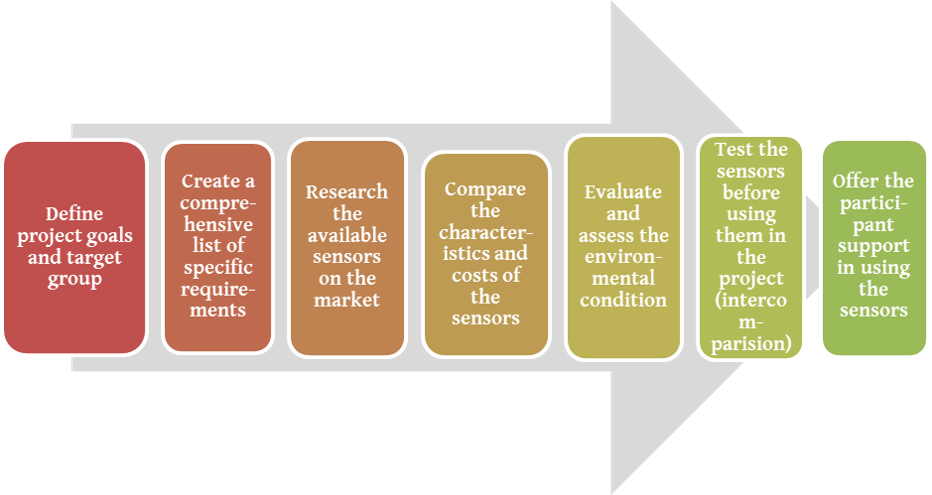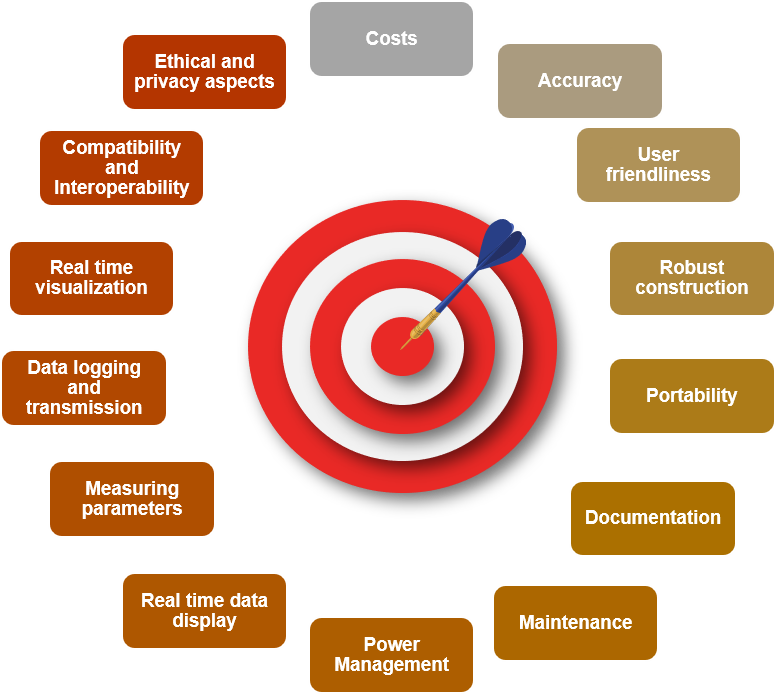Step 4: Selection and provision of sensor equipment
There are following important tasks regarding the strategy to select suitable sensors.

Citizen science projects increasingly rely on sensors to collect environmental data, facilitating public participation in scientific research. Selecting suitable sensors for citizen science projects presents unique challenges due to diverse project requirements, participant capabilities, and resource constraints.
Therefore, the process of selecting appropriate sensors requires careful consideration of several factors to ensure data accuracy, reliability and relevance to project goals. This systematic workflow is to guide sensor selection in citizen science projects, covering key steps from defining project requirements to evaluating sensor performance and compatibility. Following this workflow will ultimately increase the effectiveness and impact of citizen science initiatives by enabling project coordinators and participants to make informed decisions when selecting sensors.

| Project goals |
• What exactly does the project want to measure? • What kind of data is needed? • What level of accuracy and precision is required? |
| Target group |
• What prior technical knowledge do the participants have? • What skills and resources are available? • What is the budget? |
| Comprehensive list of specific requirements |
• Sensor characteristics: What is the desired measurement range and accuracy, sampling frequency, operating conditions, and any constraints related to budget, power consumption, or data management? • Compatibility: Is the sensors compatible with other low-cost or high-end sensors or existing hardware and software? • Scalability: The system should be scalable to allow the project to be expanded. • Data security: Does the sensor allow data securely stored and transmitted? |
| Available sensors |
• What types of sensors are available on the market (catalogues, online databases, scientific publication, social media and manufacturer information)? • Are sensor prototype description published regarding sensors developed in research projects? |
| Operating software |
• Is the software trustworthy? • Is the software well-supported? • How is user data (measurements + private info) handled? • Is the privacy and ethical issues ensured? • Is the data transferred into some cloud, maybe outside of the country of opera-tion? • Can the sensor be operated using alternative, e.g. open source software or is the user "locked in" to one vendor? |
| Comparison of sensors? |
• What are the characteristics of these sensors (e.g. measurement range, resolution, power consumption)? • What are the costs associated with the sensors? |
| Environmental conditions |
• Where will the project be carried out? • What are the environmental conditions (e.g. temperature, humidity, air pollu-tion)? |
| Intercomparison of sensors |
• Assessment of trustworthiness of data • Evaluate the difference in operation, reliability and data quality between sensors and CS sensors and high- end sensors |
| Support |
• Smartphone Apps • Web based platforms • Workshop and trainings • Data Analysis Software |
Overview of topics to be required to find a suitable sensor

| Criteria | Question |
|---|---|
| Costs |
• Is the sensor affordable for the participants? • Does the project provide the sensors to fulfil the tasks? • Which costs need the participant to cover in case of e.g. loss of the sen-sor? |
| Accuracy |
• Does the sensor manufacturer provide information on accuracy and reliability? • Does the sensor provide reasonable accuracy for the intended measurements? |
| Regulations | • Are the operation of mobile sensors including data transmission in line with international and national regulations? |
| User friendliness |
• Is the sensor easy to set-up and operate for the participants? • Are user-friendly features such as plug-and-play interfaces, intuitive software, and clear documentation available? |
| Robust construction | • Does the sensor is able to withstand several environmental conditions such as strong vibrations, temperature variations, humidity, and exposure to dust or water to enhance reliability? |
| Portability | • Is the sensor light-weighted and versatile use on foot, on a bicycle, on cars and other vehicles, allowing flexibility and facilitate data collection in field? |
| Documentation |
• Does the sensor have comprehensive documentation, tutorials, and a supportive user community? • Is the documentation available in different languages? • Is the documentation easy to access? • Does the project need to provide additional support to the participants? |
| Maintenance |
• Does the sensor only require infrequent calibration and minimal mainte-nance? • Does the sensor still have warranty coverage? • Does the manufacturer provide technical support and are replacement parts available? |
| Power Management | • Does the sensor have efficient power management, especially long bat-tery life and short charging time? |
| Real time data display | • Is a real-time display of measurements easily available on the sensor or a separate app? |
| Measuring parameters | • Are all suitable parameters measured to meet the project aim? Does the sensor record timestamp and location? |
| Data logging and transmission | • Does the sensor have the capability to log data internally and/or transmit it wirelessly to a central database or cloud platform? |
| Real time visualization |
• Is a real-time visualization of measured data available e.g. in an online dashboard? • Is this real-time visualization easy to access? |
| Compatibility and Interoperability |
• Is the sensor compatible with standard data collection platforms or proto-cols? • Are there data on inter-comparison experiments with other low-costs or high-end sensors available? |
| Ethical and privacy aspects | • Do you consider and assess ethical aspects such as data privacy, in-formed consent, and potential environmental impacts associated with sensor deployment? |
